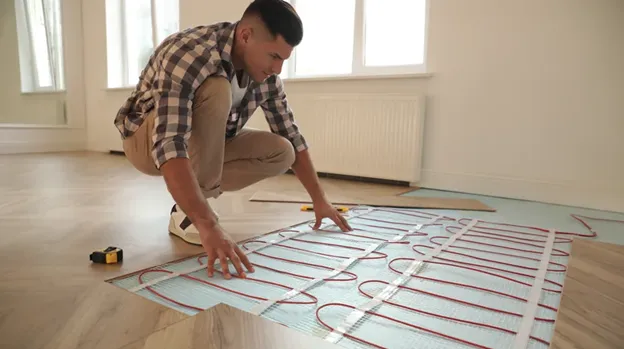(515) 608-2492
Blogs
W and W Enterprises

Radiant Floor Heating vs. Traditional Heating: Which Is Best for Your Home?
Home heating plays a major role in your comfort and utility bills, especially during the cold Iowa winters. Choosing the right system involves more than deciding between different heat sources because efficiency and long-term comfort must be considered carefully. Homeowners today are comparing radiant floor heating with traditional forced air or baseboard heating to see which offers better value.
Radiant floor heating works differently than traditional systems since it delivers warmth from beneath your flooring, distributing heat evenly across living spaces. Traditional systems, while familiar, often create inconsistent heat and dry air. Both options have benefits depending on your goals, home structure, and budget. Understanding the details of each system helps you make the right choice for your family.
How Radiant Floor Heating Works
Radiant floor heating uses a system of hot water pipes or electric heating elements installed beneath your floors. Water-based systems connect to your plumbing and circulate heated water through durable tubing placed under finished flooring. Electric systems rely on heated mats or wires, which are better suited for smaller projects like bathrooms. Both systems provide warmth directly to surfaces, creating consistent and comfortable heat.
Because radiant floor heating warms surfaces instead of circulating air, the comfort level feels much more natural. Heat rises slowly from the ground up, keeping your feet warm and maintaining a steady indoor temperature. Traditional systems, on the other hand, often create hot and cold spots depending on airflow and vent placement. You will immediately notice the even distribution once you step onto heated flooring during colder mornings.

Installing radiant floor heating requires professional planning since the system integrates with your plumbing. A skilled plumber ensures the hot water loops or electrical mats are installed securely beneath the flooring materials. Choosing the right installation method depends on the type of room, existing flooring, and your heating needs. Proper installation ensures efficiency, durability, and lasting performance.
The design of radiant floor heating makes it compatible with many flooring types, including tile, laminate, and engineered hardwood. Tile remains the most common choice because of its ability to conduct and retain heat efficiently. However, engineered materials designed for radiant heating also perform well when installed correctly. Working with a professional ensures your flooring material pairs effectively with the heating system.
Comparing Efficiency with Traditional Heating
Radiant floor heating offers efficiency advantages because it minimizes heat loss through ducts and vents. Traditional forced air systems lose energy when hot air travels through long ducts, especially if leaks or gaps exist. Baseboard heaters often require high water temperatures, consuming more energy to maintain comfort. Radiant systems instead rely on lower water temperatures while still creating a warm environment.
Because the heat rises slowly and evenly, radiant floor heating can often keep a room warm at lower thermostat settings. Lower operating temperatures result in reduced utility bills compared to systems that require constant cycling. Traditional systems may cause temperature swings, forcing the furnace to work harder. Radiant heating avoids this issue by maintaining consistent warmth without sudden fluctuations.
Efficiency also relates to indoor air quality, which impacts long-term comfort. Traditional systems push heated air through vents, often distributing dust and allergens throughout your home. Radiant floor heating avoids blowing air entirely, leaving you with cleaner and healthier indoor air. For households with allergies or asthma, radiant heating provides an additional benefit.
When considering efficiency, you should also think about long-term maintenance. Traditional systems require regular duct cleaning, furnace servicing, and filter replacements. Radiant floor heating systems require far less upkeep since the pipes or mats are sealed beneath your flooring. Reduced maintenance saves money and effort while improving overall efficiency year after year.
Comfort Levels Between the Two Systems
The comfort of radiant floor heating goes beyond simply keeping a space warm. Heat radiates directly from the floor, eliminating drafts or cold spots that occur with vents. You no longer need to rearrange furniture to avoid blocking airflow or worry about uneven heating between rooms. The environment feels natural, consistent, and cozy.
Traditional heating can create noise as furnaces cycle on and blowers push air through vents. Radiant floor heating systems operate silently because the heat source lies beneath the surface. Quiet performance improves relaxation and makes the system nearly unnoticeable while working. Many homeowners appreciate the peaceful environment it creates.
Another comfort factor comes from how radiant floor heating addresses cold surfaces. Walking barefoot on tile or hardwood in winter can feel unpleasant without an effective heating system. Radiant heat transforms those surfaces into a warm, inviting feature of your home. The result is a more enjoyable living experience for everyone in the household.
Comfort extends beyond physical warmth since radiant systems eliminate the dry air associated with forced air heating. Traditional furnaces often reduce indoor humidity, leaving your home feeling dry during winter. Radiant systems maintain more balanced air conditions without stripping away moisture. Healthier humidity levels improve comfort and reduce the need for extra humidifiers.
Installation and Long-Term Investment
Installing radiant floor heating requires more upfront planning compared to traditional systems. New construction or major remodels provide the perfect opportunity to add it since floors must be opened. Retrofitting existing homes can be more complex, but experienced plumbers can still design systems to work with current layouts. A proper installation ensures lasting performance for decades.
Traditional systems are easier to install in existing homes since ductwork may already be in place. Forced air systems remain a common choice for convenience, even if they are less efficient. Baseboard heating offers another simpler option, though it sacrifices efficiency and comfort. Weighing installation challenges against long-term benefits helps you determine which option suits your needs.

The upfront investment in radiant floor heating is often higher than traditional systems. However, lower operating costs and reduced maintenance balance those expenses over time. Many homeowners view radiant heating as a long-term investment rather than a short-term purchase. The added value of comfort and energy savings makes the decision worthwhile.
Durability also plays a role in the investment decision. Radiant systems, once installed properly, can last decades without needing major repairs. Traditional furnaces and duct systems often require replacements sooner due to wear and tear. A system with minimal maintenance needs can save you significant money throughout its lifespan.
Deciding Which Heating Option Is Right for You
Your decision between radiant floor heating and traditional heating depends on priorities such as comfort, efficiency, and installation feasibility. If you plan a new bathroom or whole-home renovation, radiant heating delivers unmatched benefits. Traditional systems still serve a purpose for quick installation or budget-conscious projects. Comparing both options carefully ensures you make an informed choice.
Radiant floor heating provides superior comfort through even heat distribution and healthier indoor air quality. Traditional heating remains a practical option if ductwork already exists, though it may sacrifice efficiency. Evaluating your household’s heating needs helps identify the system that will perform best over the long term. You should balance both comfort and cost when making the decision.
Budget also influences your choice since radiant floor heating carries a higher initial price. However, the energy savings, durability, and improved comfort offset the expense over time. If you value immediate affordability, traditional heating may remain suitable. If long-term investment appeals to you, radiant heating offers a compelling solution.
Discussing your options with an experienced plumbing professional ensures the right design for your home. A professional evaluates your existing layout, heating goals, and installation challenges before recommending a system. The expertise ensures safety, reliability, and efficiency from the start. Choosing the right professional makes the decision process straightforward.
Choosing Radiant Floor Heating for Lasting Comfort
Radiant floor heating offers efficiency, comfort, and health advantages that traditional heating systems cannot match. Traditional heating still provides convenience and affordability, but it often sacrifices comfort and long-term performance. The right decision depends on your home, budget, and personal preferences.
If you want professional guidance on radiant floor heating installation, W and W Enterprises provides expert plumbing services designed to improve your home. Our team delivers tailored solutions for bathrooms, plumbing system upgrades, water line replacements, and full custom projects. Contact W and W Enterprises today to explore how radiant floor heating can transform your comfort.

© 2025 W and W Enterprises. All rights reserved.
Privacy Policy
Terms of Service